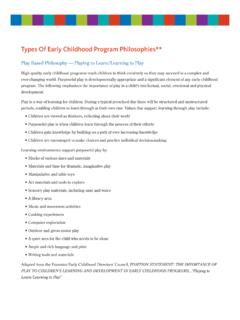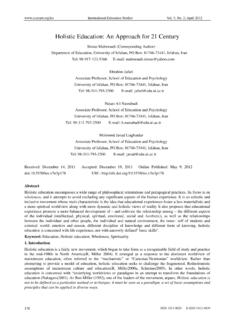Transcription of The six basic exercises by Rudolf Steiner - AntroVista
1 The six basic exercises by Rudolf Steiner Tom van Gelder March 2011. 1. Introduction Rudolf Steiner has given six simple exercises to develop and purify thinking, feeling and willing. They are called basic exercises or additional exercises ((German: Neben bungen) because you can do them in addition to meditation. Even if you do not want to meditate, these exercises are good to do. You get to know yourself better and life becomes more interesting. Thinking, feeling and willing are parts of the soul. By practising them - first separately (thinking, feeling, willing) and then in combinations - you develop your soul. There are several reasons to do these exercises : In meditation thinking, feeling and willing become detached from each other and can go their own way. In ordinary life, too, one may observe disconnection between thinking, feeling and willing.)
2 You feel something and you think something that has no connection with that feeling. you may feel pity, but you think: 'that's not my problem'. Or you do something, which you did not think about and with which you are not satisfied. you watch television and see someone eating peanuts, you go to the kitchen and take some and eat them, and then you think: 'why am I eating peanuts, did I want to do that?'. With these exercises you will strengthen integration of the three. Sometimes you may find that thinking, feeling and willing happen automatically and that some thoughts, feelings and actions are not so pretty. By doing the basic exercises , you can purify them. 2. The six exercises 1. Control of thought aims to gain control over what you think. 2. Control of will aims to gain control over your actions. 3. Equanimity - the exercise of feeling - aims to be aware of your feelings, to weaken strong feelings and strengthen weak ones and to balance them.
3 4. Positivity aims to see the positive in addition to the bad and the ugly. In this exercise thinking and feeling are combined. 5. Open-mindedness aims to be always open to new experiences. In this exercise feeling and willing are combined. 6. Inner harmony: the sixth, in which the previous exercises need to be practised in order to create harmony between thinking, feeling and willing. The goals of the exercises To be more aware of how you think, feel and act. To gain more control over thoughts, feelings and actions. To think, feel and act more clearly. To make a harmonious whole of thinking, feeling and willing. You can practice alone or in a group. The latter enables you to exchange experiences, to stimulate each other and to maintain the exercises for a longer period. They may seem easy to do, but are not so easy to maintain for four weeks.
4 It may seem that everyday life asks so much of you that there is no time to do the exercises . It may be helpful to write down your experiences every day: what exercise you have done and how it went. Although Steiner made several statements about the duration of the exercises , it is generally recommended that all exercises are done consecutively and in the mentioned order for four weeks. After 3. having practised for four weeks, the acquired skills form a habit that will be included in your vital or etheric body. When you start an exercise, the first week you are enthusiastic because of the novelty of the exercise. So first you are pulled forward by the exercise. Somewhere in the first or second week the novelty has gone and you have to do the exercise by yourself - you have to generate enthusiasm inside yourself. It becomes more difficult to do the exercise, you need to invest more, which also makes the effect of the exercise stronger.
5 It may be quite effective if you do each exercise one week and then take the next one - so you do exercises for a week alternately. How you do the exercises is ultimately up to you, your possibilities and your interest. Take them seriously, but not too seriously; they should not be a duty. Humour gets you further! Literature Dam, J. van, 1999. Het zesvoudige pad. Vrij Geestesleven, Zeist (Dutch). Steiner , Rudolf , 1910. An outline to esoteric science. Steiner books. Flensburger Hefte 47, 1994. bungen zur Selbsterziehung (German). 4. Control of thought Use an ordinary object (a pencil, clothe spin, clip, book, etc.) and think about it for five minutes every day. You take an object in front of you or in your mind and the first time you describe it to yourself aloud. You can also imagine yourself describing it to a blind person. Use all your senses and make as many observations as you can in five minutes.
6 Repeat this the next day, you will probably notice new details. After a while you can ask questions about the object: "What can I do with it?", "What is it made of?", "Why this shape?", "What other shapes could it have?", "Where was it made?", "How did I get it?"," How are the raw materials mined?", etc. You will be able to answer some of these questions. If not, you can search for an answer in an encyclopaedia or on the internet. Your should be able to determine whether your thoughts are correct, otherwise your thoughts will wander. which is not the intention. You can repeat what you did the day before and build on your previous thoughts. After some time you will have covered all possible questions, then do it one or two more times until you can really find no more issues to think about. Then follow the same procedure with another object.
7 When doing this exercise you may notice that your thinking gets clearer and sharper, and that your perception, concentration and objectivity increase. Also, your interest grows. The difficulty of the exercise is that your mind wanders. The challenge is to be able to think about the object for five minutes, but you will find that your mind wanders to something else very easily, that your thoughts are associative and work automatically. you think of a pencil and suddenly you see in your mind your grandma with a pencil in her hand, grandma has a budgerigar and suddenly you are thinking about the whistling of this bird. Interrupt such thoughts: you wanted to think about the pencil. Another difficulty may be that you do not have the answers to the questions. However, 5. nowadays it is easy to find them on the internet. The exercise is called control of the mind.
8 The example just given shows that often there is no control over our thinking. We are thought, our thinking is associative and automatic. We believe that we think, but our thinking is often not focused. Make sure that you do the exercise every day. You can choose a fixed time. Choose a time when you are awake and clear-headed, so not after dinner, but for example before or after breakfast or at 8. o'clock at night. You can also do it while waiting for the train, in a spare moment. Doing the exercise with two or three objects should be sufficient. 6. Control of will - acting on your own initiative Do a simple act without purpose at a fixed time each day. You decide to do a simple act daily at a fixed time during an period of four weeks. This act does not have a direct meaning and is only useful as an exercise. The act could be anything, pulling your left earlobe, taking out your handkerchief and putting it back into your pocket again, untying and tying your shoelaces, rolling back one sleeve of your sweater, or deflating and re-inflating the tire of your bike.
9 The variations are endless, but make sure that you have the necessary attribute with you when you need it. You can do the exercise at the same fixed time every day, or - and this is more difficult - you can decide on a time each day in the morning. The difficulty of this exercise is not to think of a senseless act, but to do it every day at the time set by yourself. Often you think of doing the exercise an hour before the set time, again fifteen minutes before the set time, five , and then the phone rings or someone says something to you and the next time you think about the exercise it is an hour later. And you really wanted to do the exercise! Still, you were preoccupied with what others wanted from you or you were distracted by some thought that came along. If you are late for the exercise, it is still good to do it. The meaning of the fixed time is that you must keep your aim and at the same time restrain yourself until the time has come.
10 Your awareness of what you really want will grow by this. The exercise is called acting on your own initiative. The goal is to take the initiative in your actions, to better direct your will and to your stand fastness. 7. Many, if not most actions in a day are done because they have to be done or they are done for other people. There are not many acts that we really do for ourselves. The exercise is a commitment to yourself to do something. Such a commitment is harder to keep than a commitment to someone else. Some tips to make this exercise a success: It helps to choose a time that is easy. If you wake up every day at seven you can do it shortly thereafter. If you eat every day at six, at ten to six. Often you will see that when you are in a different rhythm, the exercise is more difficult to do. You will succeed during the week, for instance, but not so easily in the weekends.







